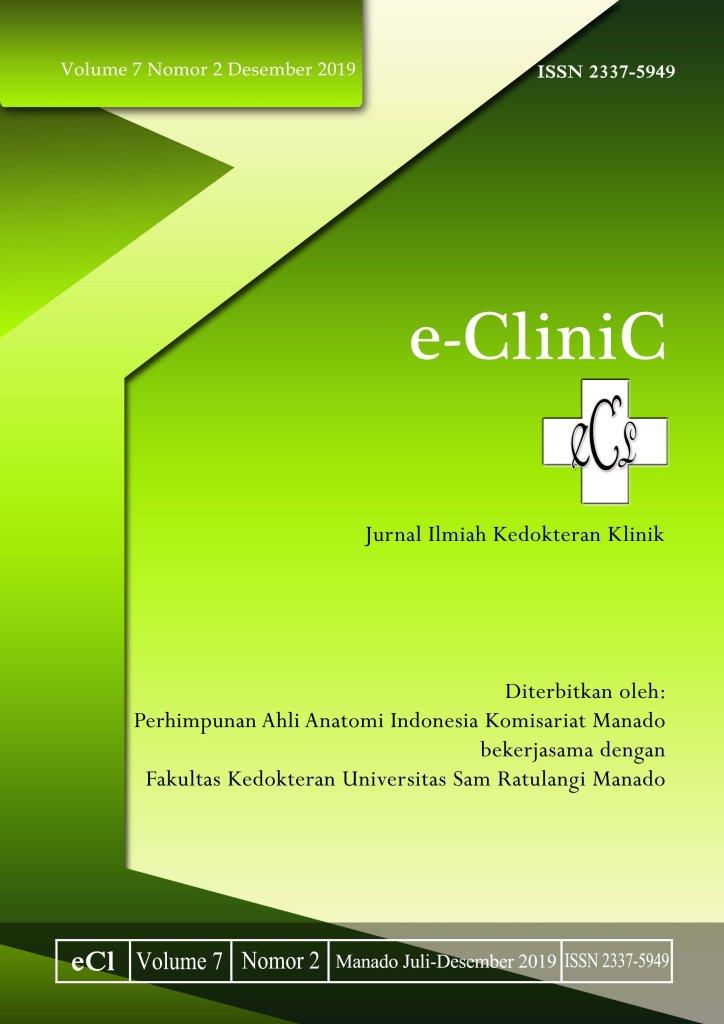Gambaran Komplikasi Penyakit Ginjal Kronik Non Dialisis di Poliklinik Ginjal-Hipertensi RSUP Prof. Dr. R. D. Kandou Periode Januari 2017 – Desember 2018
DOI:
https://doi.org/10.35790/ecl.v7i2.26878Abstract
Abstract: Chronic kidney disease (CKD) is still a global health problem with a rising prevalence in many countries. Complications of CKD are inter alia cardiovascular disease, hypertension, anemia, electrolyte disturbance, diabetes mellitus, and metabolic asidosis. This study was aimed to provide an overview of CKD at the Kidney-Hypertension polyclinic of Prof. Dr. R. D. Kandou Hospital. This was a descriptive retrospective study using data of CKD patients at the Kidney-Hypertension Polyclinic from January 2017 to December 2018. The results obtained 63 CKD patients consisting of 47.61% males and 52.38% females. Based on CKD staging, the eprcentages of patients were, as follows: stage 3 CKD (1.58%), stage 4 CKD (22.22%), and stage 5 CKD ND (76.19%). Patients aged 50-59 years had the highest percentage of stage 5 ND CKD numbering 10 males (20.83%) and 12 females (25%). The prevalences of complications in stage 5 ND CKD compared to stage 4 CKD were, as follows: anemia Hb 11-11.9 g/dL (77.5% vs 36.36%), uncontrolled hypertension (37.50% vs 14.28%), dyslipidemia (25% vs 28.57%), hyperurisemia (27.08% in males and 41.67% in females vs 57.15% in males and 28.57% in females), hyponatremia (66.67% vs 64.28%), hypernatremia (31.25% vs 0%), and hypokalemia (16.67% vs 35.72%). In conclusion, CKD complications were anemia, hypertension, dyslipidemia, hyper-urisemia, and electrolite imbalance; most were higher in stadium 5 ND CKD.
Keywords: chronic kidney disease, complications
Â
Abstrak: Penyakit ginjal kronik (PGK) masih menjadi masalah kesehatan global dan prevalensinya terus meningkat di berbagai negara. Komplikasi PGK antara lain penyakit kardiovaskular, hipertensi, anemia, gangguan elektrolit, diabetes melitus, dan asidosis metabolik. Penelitian ini bertujuan untuk mengetahui gambaran komplikasi PGK di Poliklinik Ginjal-Hipertensi RSUP Prof. Dr. R. D. Kandou. Jenis penelitian ialah deskriptif retrospektif dengan menggunakan data pasien PGK yang dirawat di Poliklinik Ginjal-Hipertensi periode Januari 2017 - Desember 2018. Hasil penelitian mendapatkan 63 pasien PGK, terdiri dari 52,38% perempuan dan 47,61% laki-laki. Berdasarkan stadium PGK, PGK stadium 3 (1,58%) orang, PGK stadium 4 (22,22%), dan PGK stadium 5 ND (76,19%). Kelompok usia tertinggi ialah 50-59 tahun. Prevalensi komplikasi pada PGK stadium 5 ND dibandingkan PGK stadium 4 ialah sebagai berikut: anemia Hb 11-11,9 g/dL (77,5% vs 36,36%), hipertensi tidak terkontrol (37,50% vs 14,28%), dislipidemia (25% vs 28,57%), hiperurisemia (27,08% pada laki-laki dan 41,67% pada perempuan vs 57,15% pada laki-laki dan 28,57% pada perempuan), gangguan elektrolit hiponatremia (66,67% vs 64,28%), hipernatremia (31,25% vs 0%), dan hipokalemia (16,67% vs 35,72%). Simpulan penelitian ini ialah komplikasi PGK ialah anemia, hipertensi, dislipidemia, hiperurisemia, dan gangguan elektrolit; sebagian besar lebih banyak terjadi pada PGK stadium 5 ND.
Kata kunci: penyakit ginjal kronik, komplikasi
Downloads
How to Cite
Issue
Section
License
COPYRIGHT
Authors who publish with this journal agree to the following terms:
Authors hold their copyright and grant this journal the privilege of first publication, with the work simultaneously licensed under a Creative Commons Attribution License that permits others to impart the work with an acknowledgment of the work's origin and initial publication by this journal.
Authors can enter into separate or additional contractual arrangements for the non-exclusive distribution of the journal's published version of the work (for example, post it to an institutional repository or publish it in a book), with an acknowledgment of its underlying publication in this journal.
Authors are permitted and encouraged to post their work online (for example, in institutional repositories or on their website) as it can lead to productive exchanges, as well as earlier and greater citation of the published work (See The Effect of Open Access).







